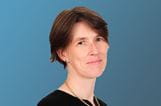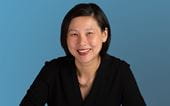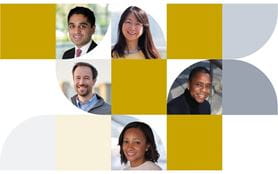Charting a course for greater inclusion in a year of accelerated change
Related people
Headlines in this article
Related news and insights
Blog Post: 18 March 2024
Blog Post: 12 March 2024
Is it OK for non-Muslims to be curious and ask questions about Ramadan?
Blog Post: 29 January 2024
Equality Update – a review of recent legislative developments
Blog Post: 21 December 2023
D&I in FS: how to get a head-start on the FCA and PRA proposals
A&O’s five new Regional Diversity and Inclusion (D&I) partners reflect on their first year in the role and the impact events of 2020 have had on D&I at the firm.

Stepping into the new role of Regional Diversity and Inclusion partner for A&O was always going to mean a busy first year for the five partners: Hendrik Jan Biemond in continental Europe, Fiona Cumming in Asia Pacific, Ian Field in the UK, Elizabeth Leckie in the U.S. and Kathleen Wong in the Middle East and Africa.
But with Covid-19 spreading across the world and the most widespread antiracism protests for decades, 2020 as been a year of steep learning curves and accelerated change – a year that has brought significant challenges for D&I but also opportunities to speed up progress.
“It has certainly been a year of big events,” says Elizabeth Leckie, “both in the U.S. and globally. But I think that has galvanised us – internally as a firm but also as a profession.” The reality of systemic inequalities has come into focus more strongly, in particular with the greater impact Covid-19 is having on the most disadvantaged individuals, and the reality of racial inequality highlighted by the Black Lives Matter (BLM) protests.
“Thinking about diversity is not new for us in the U.S., or as a firm,” Elizabeth says, “but what’s different now is a stronger acknowledgement that we must address these issues more openly, be comfortable speaking about them and be prepared to be accountable for them – nobody can ignore this.”
Kathleen Wong has seen a similar consensus develop across her region. “I’d say the biggest progress we’ve made is increased awareness and acceptance that, no matter where you’re from or where you work, D&I is crucial to the success of our business.
We’ve put a spotlight on these issues and are talking more about them: what’s going well, what isn’t working, how we can improve.”
These experiences bind us, not just as co-workers but also as human beings.
The need to tackle racial inequalities
While there are different priorities for different offices, achieving racial equality is top of the agenda in South Africa, Kathleen says. “The BLM demonstrations resonated deeply here. They prompted people of all backgrounds to set up a #BLM Discussion Group in our Johannesburg office to find ways of driving positive change in a South African context.”
As Kathleen points out, the issues are extremely relevant and certainly not new in South Africa. “Addressing racial inequalities is enshrined in law and touches everything we do, from increasing the proportion of black colleagues in senior roles to creating opportunities for local businesses in our supply chain.
“Our people have their own unique experiences and perspectives of overcoming racial injustice – they want to share them so that we can help to shape change both locally and within our network.”
Meanwhile, in Europe, Hendrik Jan Biemond says discussions around D&I had until recently for some still felt “quite abstract” in certain areas. “Now there is more urgency to them, particularly on race and ethnicity after the death of George Floyd.
“Anti-racism protests have taken place in all European capitals. I was in the Dam Square demonstration and really felt it was a turning point. The stories that have come out about racism in our society have made people more aware of the inequalities we must address, not least in looking at ethnicity alongside socio-economic disadvantage. That is the beginning of a process of improvement and we must keep the discussions alive.”
Helping those that are invisible to the business world
In Asia Pacific, there is a similar issue to understand, says Fiona Cumming. “In terms of ethnicity, in Hong Kong, for example, the population is 93% ethnically Chinese, so the percentage of ethnic minorities is relatively small.
“But those minority groups – Nepalese, Indonesian, Filipino – are concentrated in the lowest socio-economic groups and practically invisible to the business world. The same is true in Australia with the indigenous communities.
“There’s a lot to do simply to create better access to education in many parts of this region, so we’ve been working with partner NGOs to address that. We need to keep refreshing our learning about what the barriers are and what we can do to help bring them down.”
More broadly across Asia Pacific, offices are not starting from the same position across the different strands of D&I, Fiona says. “What I’ve taken from speaking to our people, though, is how engaged they are with this subject and how much more confident they’ve become in using their voices. From that, I’ve learned a huge amount about the different challenges and perspectives each country has, which means we can put together concrete action plans with full partner endorsement.”
For Ian Field in the UK, 2020 has brought an opportunity to speed up progress. “Race and ethnicity was always going to be a big area of focus this year, as we’d already completed a broad review of retention and progression in London to understand where more action was needed.
“At trainee level, we’re close to where we want to be with the proportion of ethnic minority lawyers – those who identify as ethnically not white – at around 31%, which reflects the percentage in UK higher education,” Ian says. “But black graduates are under-represented within that, and the numbers overall decline the higher up you get within A&O.”
The firm introduced a strategy and set of targets to improve racial diversity in London focused on recruitment, retention and culture. “We had begun talking this through with partners at the start of the year,” Ian says, “but the events that followed gave us a huge acceleration in getting buy-in for the strategy.”
Targets and accountability change conversations around talent – they make us confront barriers to progression and consider people who, for many reasons, might have been overlooked in the past.
Targets everybody can work towards
Introducing targets in any area of D&I is, Ian acknowledges, controversial. But, having introduced a 30% target for the proportion of women candidates in the partner promotion process nearly three years ago, the firm has made significant progress. In 2020, 45% of newly promoted partners globally were women.
“I think our progress with gender is attributed in large part to having something measurable to work towards that everybody can see,” says Ian. “Targets and accountability change conversations around talent – they make us confront barriers to progression and consider people who, for many reasons, might have been overlooked in the past. That principle is central to improving our pipeline of ethnic minority lawyers as well.”
For Kathleen, gender equality, especially among the senior ranks, is a key priority in the Middle East. “There is a real call to action, both internally and from clients demanding change across the region. As a result, the work we’re doing has evolved from how to support women as mothers to how we increase women’s profile and visibility.”
The Dubai office recently ran a women’s development programme with several clients and A&O associates from Abu Dhabi, Dubai and Johannesburg. “It was a powerful platform to share experiences,” Kathleen says, “a common one being that you’re often the only woman in a meeting room, so how do you handle that?
“We had a group of such smart, strong women on the programme that it hit home just how much of a disservice we’d be doing them – and A&O – if we don’t work hard to ensure they stay and progress here.”
Fiona points out that achieving 45% women in this year’s partner promotions does not mean the challenges for women have gone away. “We have to continue with what we can see is working: monitoring our pipeline, developing and sponsoring women effectively, encouraging flexible career paths and doing more to support working parents.
“But what it does show,” she says, “is that a sustained effort to think through the issues and impediments can change outcomes. Now we need to keep pushing forward so that this progress starts to impact the overall percentage of women partners we have globally.
“We’re currently at 20% and are aiming to get to 30% initially, as that’s been shown to be the threshold at which group-think and decision-making start to change. But 30% is not the final goal.

The importance of allies and networks
A key area of progress for Hendrik Jan in Europe has been the growth of A&Out, the firm’s LGBTQ+ network. “I’m seeing a much more visible LGBTQ+ community across our offices,” he says. “In the past year we’ve had A&Out launches and celebrations in Germany and Warsaw; Paris has signed its own Diversity Charter and put up an LGBTQ+ Allies Wall; and our associates in Prague have presented to Pride Business Forum members on equal rights for LGBTQ+ employees. Five years ago, this sort of support and activity just wasn’t there to the same extent.”
During Pride month in June, offices around the world replaced the usual marches and celebrations with virtual events. Partners and staff sent photos of themselves to create a collage of the Progress Pride Flag with black and brown stripes to show racial inclusion.
“For the LGBTQ+ community, visibility is key,” Hendrik Jan says, “so lockdown has been potentially very isolating for people who can’t be openly ‘out’ at home. In the current crisis, it’s important to continue to be active allies and show explicit support.”
Fiona says events in 2020 in many ways have educated people more about what it means to be a good ally. “I’ve heard colleagues from minority groups articulate so effectively what they need from an ally – for example to amplify their voices, not speak on behalf of them.
“The act of becoming an ally moves you away from thinking it’s always somebody else’s problem. Instead, you bring things back to yourself, your team, your profession, with a new level of self-scrutiny. You help to drive discussions which then build the momentum for change.”
Elizabeth says A&O’s networks and affinity groups in the U.S. – the Asian and Black and Latinx Affinity groups, A&Out, the Women’s Committee and A&O Families – have been a great source of collegiality and inspiration.
“They create really vibrant conversations: internally across practice groups, teams and between our New York and Washington, D.C. offices; and externally in how we engage through them with alumni, clients, bar associations and students. Finding ways to talk about these topics and address change together is so important and something that I hope we see more of this year.”
It has certainly been a year of big events. But I think that has galvanised us - internally as a firm but also as a profession.
Culture is key
For Ian, the ultimate goal is inclusion. “What we are really trying to do is break down barriers, respect the differences we all have and allow people to be themselves,” he says, “not feel they have to assimilate into some historic vision of what an A&O lawyer is.
“The debates we’re having – on gender, race and ethnicity, disability, social mobility, LGBTQ+ inclusion, trans rights – together produce a sort of virtuous circle. Each layer builds on another and that makes me hopeful that we will see faster progress.”
Elizabeth agrees. “We’ve come together as a group of five partners and we are genuinely challenging ourselves. It makes this feel like a firm-wide effort rather than something we each address locally.
“As well as the hard analysis around talent pipelines, development, distribution of opportunities and progression, what we’re talking about is much more wide-reaching. It’s about our future; what kind of business we want to be.”
Fiona believes it’s also crucial to engage with clients and peers. “We want to pool our knowledge and ideas so that we’re changing mindsets on diversity across our whole industry – it’s not a competition.
“I do feel that we engage more proactively now about our actions and intentions, both with our people and clients”, she says, “rather than waiting to be asked specifically about D&I in, say, a client relationship meeting. We’re more confident across the whole partnership on this.
“It’s a journey we’re still on but I can see that we’ve made progress even over the past few months. That’s really positive.”
Ian agrees. “If you ask me what I hope to achieve during my tenure as a D&I partner, it would be to succeed in achieving enough diversity across our business that we can move on to really focus on inclusion. We play a key role, as D&I partners, in driving engagement across the wider partner community.
“In that respect, what’s happened in 2020 has helped us to achieve traction at a pace far beyond anything we could have hoped for.”
Can a global pandemic accelerate change?
One thing the partners have all witnessed in their regions is the impact of the Covid-19 pandemic on the nature of working relationships.
“Lockdown has led us to question how we all interact in our work environment,” Elizabeth says. “Working from home, for example, has really shone a light on the difficulties working parents face.
“Generally we have a better sense of what’s going on in people’s lives than when we were all just commuting into the office. That, plus the international reaction to the death of George Floyd, has led to much soul-searching and self-education, which is all for the good.”
Hendrik Jan believes that reassessing how teams interact without the ease of communication in an office environment has made people think more about engaging with team members at all levels. “If we don’t, then remote working can break down very quickly for some people. We’ve had to think carefully, for example, about the experiences of our disabled colleagues to ensure we’re providing any specific help they need to work effectively from home.”
Being in lockdown has led to a lot of introspection, he says. “People are questioning, why am I here as a lawyer? What kind of firm is A&O exactly? I think that’s a strong platform for D&I discussions – they go hand in hand. I know there were concerns that attention would turn away from diversity as other business considerations took precedence, but actually I think it’s the other way around.”
South Africa, Kathleen explains, has experienced extreme challenges during lockdown, with many communities facing shortages in electricity and food. “We’ve connected far beyond work during this crisis,” she says, “exchanging tips on things like where to find food. We’ve seen into each other’s homes on video calls and been able to give support to team members cut off from family and friends. These experiences bind us, not just as co-workers but also as human beings.”
One area of concern more broadly across the legal profession, however, is that the trend seen during the global financial crisis repeats itself. As Ian says: “We know that women and ethnic minority lawyers disproportionately left the profession in that period, particularly when restructurings happened.
“We’re heading into another period of economic turbulence in 2021, but I believe these issues have taken on too much importance to roll back. In fact, we’ll need people who can think differently now more than ever to navigate the next few years.”

Download the yearbook
Read our full Alumni Yearbook 2020
Download PDF





